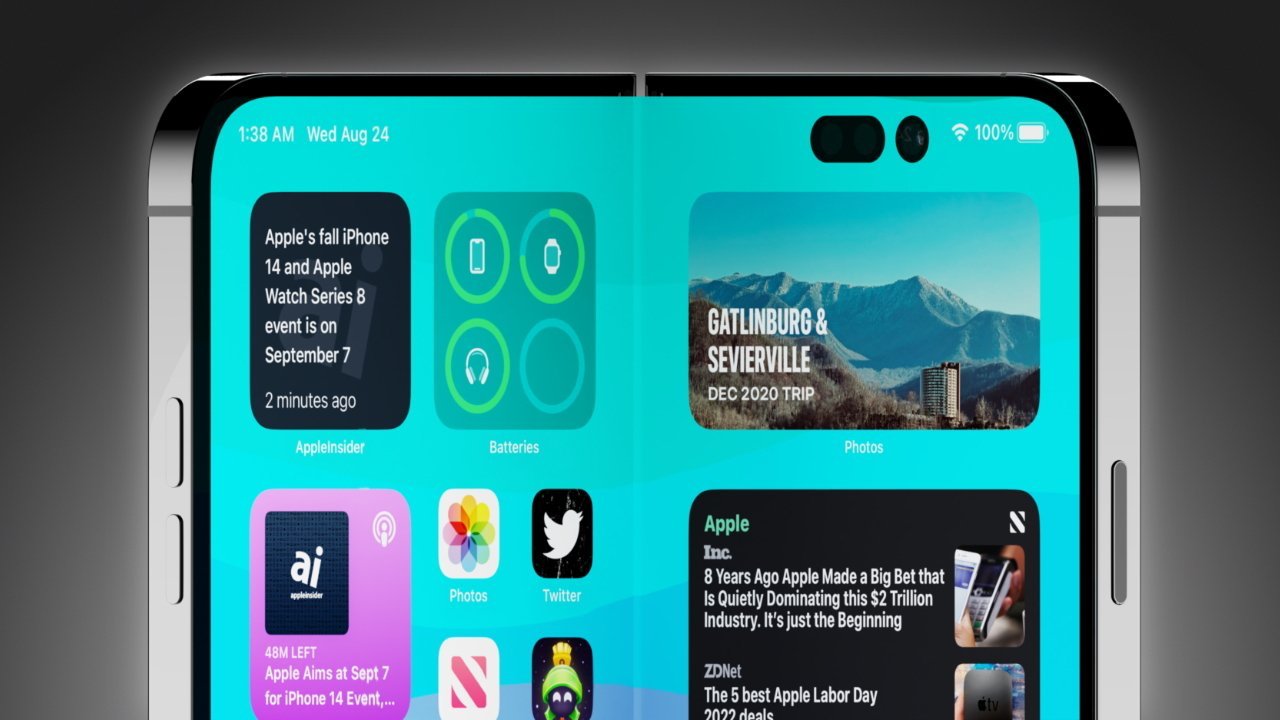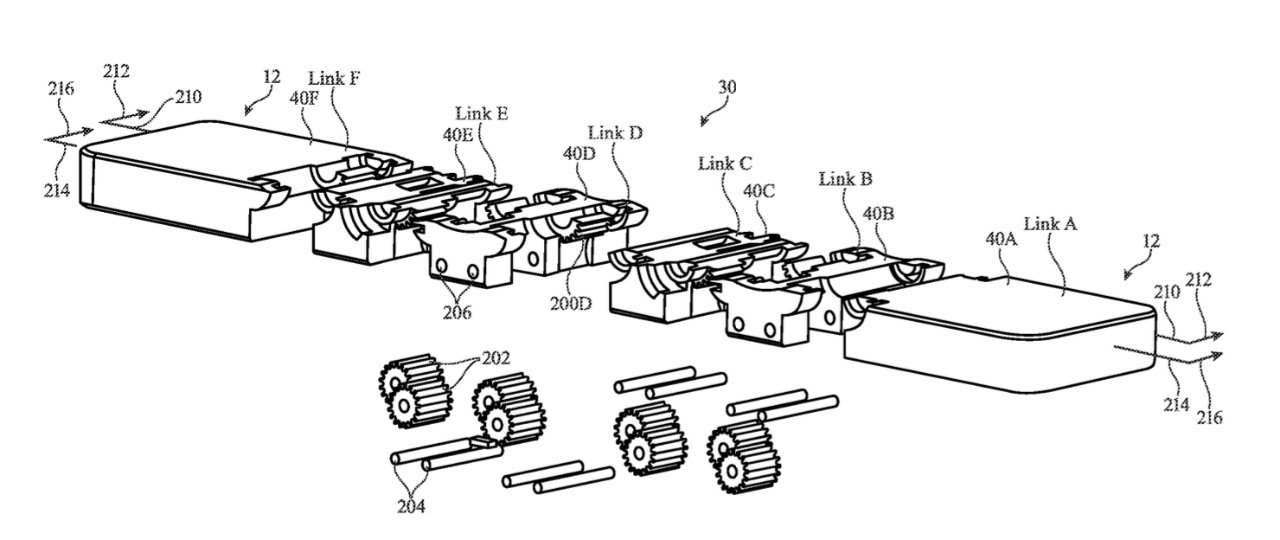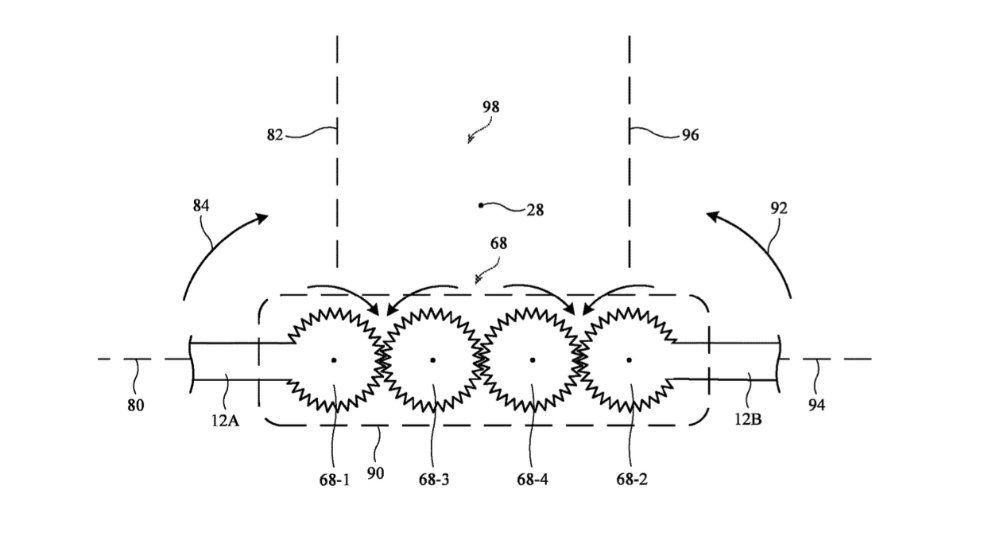Apple continues to evolve the hinge it may use on a folding iPhone
A newly-revealed patent application shows Apple has evolved its previous hinge designs, and is now describing foldable iPhone displays with far more intricate gearing.
When a folding iPhone, iPad, or even MacBook Pro is eventually launched, its fold hinge is likely to look typically smooth and simple. On the inside, however, it now looks as if Apple is at least favoring a design with an interlocking mesh of gearing.
Previous design drawings have shown at most three to four small cogs revolving around a single larger one. The new patent application, entitled "Hinges for Folding Display Devices," includes designs with four pairs of seemingly small cogs, worked into a complex assembly of six static parts.
"A foldable display device may have housing portions coupled by a hinge," says Apple. "The hinge may have a series of interconnected links... the links may be formed from interdigi-tated fingers in a friction clutch."
Alongside gears or cogs that allow for movement, Apple also describe pins that keep the apparatus travelling along set directions.
"The fingers or other portions of the links may be provided with crescent-shaped slots that receive pins," continues the patent. "During folding of the device, the pins may slide along the crescent-shaped slots, thereby ensuring that adjacent links rotate relative to each other about a rotation axis that lies outside of the hinge and within a flexible display panel."
A separate sketch shows a row of four directly interlocking cogs, while others look to describe gears within different rigid elements.
"Links may also be formed from link members with curved mating bearing surfaces that slide relative to each other as adjacent links are rotated relative to each other," says Apple. "A housing rotation synchronization mechanism may be formed using a set of gears that extends between the first and second housing portions."
All of this suggests that Apple is moving away from one or more large hinge mechanisms, to a system that leverages many smaller gears. The newly-revealed patent application appears to be more complex and involved than earlier ones.
It's possible that Apple may be pursuing more than one design for hinges, though. Previous patents and patent applications have appeared to clearly be for iPhones or iPads, but this one specifically describes a wider range of devices, going from large to small.
"[The device] may be a cellular telephone, tablet computer, laptop computer, wristwatch device or other wearable device, a television, a stand-alone computer display or other monitor, a computer display with an embedded computer (e.g., a desktop computer)," it says, "[or] a system embedded in a vehicle, kiosk, or other embedded electronic device, a media player, or other electronic equipment."
Patents are always written to encompass as wide a range of possible applications of their technology, however. Also, while the new design appears to be a development of the previous ones, it could also be that Apple is still researching both.
The patent application is credited to 10 inventors, including Bradley J Hamel, whose previous work includes a granted patent about friction hinges. There's also Kevin M. Robinson, previously listed on a patent application regarding a hinge mechanism, probably for the MacBook Pro.
Apple has long been reported to be working on an iPhone fold. More recently, however, there have been claims that it will instead concentrate on folding iPads and the MacBook Pro.
 William Gallagher
William Gallagher
















 Amber Neely
Amber Neely
 Thomas Sibilly
Thomas Sibilly
 AppleInsider Staff
AppleInsider Staff

 Malcolm Owen
Malcolm Owen
 Christine McKee
Christine McKee










27 Comments
If anyone can perfect this it's Apple. Their notebook hinges have been excellent since at least the early MacBook (Pro) notebooks. One finger control and it just stays where it was put. I can't recall ever having an issue with those hinges.
I have to compliment Apple on committing the resources that go into patents like this for the sole purpose of convincing Samsung to throw yet more millions down the rat hole of folding smartphones, a segment that will never be profitable.